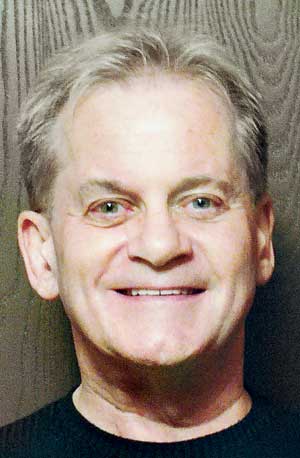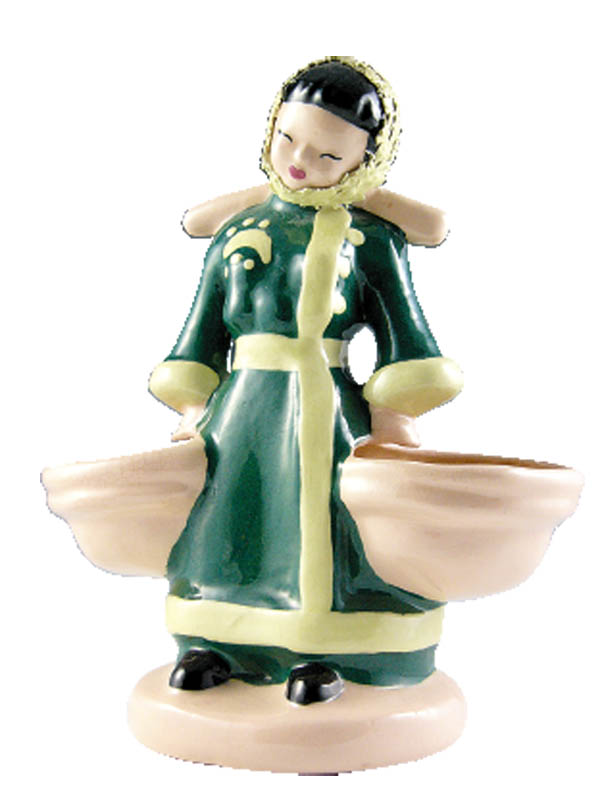Hedi vs. Kay: The Case Of The 'Copied' Ceramics
Design Trends In The Mid-20th Century
"Injunction Won by Sculptress: Former Employee Accused of Copying Her Creations"
"Suit for an injunction in which Hedi Schoop, sculptress, complained that a former employee had copied her line of statuettes, figurines, and other bric-a-brac to compete against her commercially was decided in her favor yesterday by Superior Judge Arthur Guerin.
"The court granted Miss Schoop an injunction restraining Miss Katherine Schuefftan, described as the former employee, from displaying and selling the line which Miss Hedi Schoop complained is like or very similar to hers.
"Originally, Miss Hedi Schoop also had asked for $10,000 damages, but the monetary plea was dropped during the trial."
It may not have been front-page news, but this early 1940s lawsuit, pitting one California ceramist against another, had all the drama of All About Eve, (at least in the decorative arts world.) An established design diva spouts fire when an up-and-comer, (even worse, a former employee), attempts to make inroads on her home turf? What a conversation-starter at the next giftware-buyers gathering!
The adversaries: ethereal, and wildly popular ceramics queen Hedi Schoop, versus her former protégé, the equally talented Katherine Schuefftan, (known professionally as Kay McHugh, releasing ceramics under the markings "Kaye" and "Kaye of Hollywood").
As they say on those TV shows, "the litigants are on their way into the courtroomright now!"
The Plaintiff: Miss Schoop
Hedi Schoop could have been a 40s film star. She had an unusual first name, pronounced just like Hedy Lamarrs. She had sultry cover-girl looks, reminiscent of Lauren Bacall. She had an exotic overseas background, on the order of Marlene Dietrich. There were even glamorous Hollywood connections: her sister was acclaimed ballerina Trudi Schoop, her husband, famed movie composer Frederick Hollander. (Among his hits: the languid "Falling in Love Again".)
Instead, Schoop opted for life as a ceramics designer. And, while her come-hither personal appeal no doubt caused dowdier contemporaries to shake their bunned heads in dismay, it was talent that made Schoop one of the most popular (and most imitated) ceramic artists of the 1940s and 50s.
Born in 1906 in Switzerland, Schoop spent her early years studying sculpture, fashion design, and acting. With Hollander, she fled Nazi Germany in the early 1930s, settling in Hollywood, where his composing career flourished.
In her new environment, Hedi amused herself by creating plaster dolls, which she then painted and dressed in fashions of the day. A successful showing of the dolls at a Los Angeles department store prompted Schoop to adapt her ideas to a more permanent medium: ceramics. Early slip-cast figures sold well from her small workshop, and a larger, North Hollywood facility, Hedi Schoop Art Creations, opened in 1940. The impact was immediate, as evidenced by the praise lavished on Hedi that year in a Los Angeles Times ad for Barker Bros.:
"We searched out the creator of these appealing flower and candle holders, and found a young lady from Switzerland, looking remarkably like her own wistful little flower girls. Her name is Hedi Schoop, and she creates the most charming pottery figures weve ever seen. She tells us she not only designs the pieces, but does all the molding and coloring, so that every piece is very much her own execution. Very whimsical and smart!"
Many Hedi Schoop figurines came equipped for secondary uses from flower-holders and wall pockets, to candlesticks and soap dishes. Hedi was perhaps the most commercially successful California ceramics designer of the postwar period, and certainly the most ubiquitous. If a Schoop figure proved popular with consumers, an entire line of accompanying décor objects, such as planters, bowls, ashtrays, and candy dishes, would be built around it. At its busiest in the late 1940s, the studio produced over 30,000 giftware items per year, and employed over fifty workers.
Hedi Schoop figurines are largely representational, and achieve their visual impact through overall shape and size, rather than through minute detailing. The figures are often caught in motion arms extended, skirts aflutter, heads bowed but that motion is fluid and unhurried. Rough and incised textures combine with smooth ones; colorful glossy glazes contrast with bisque. Her subjects ethnic dancers, musicians, peasant boys and girls are captured at a specific moment in time. While figurines by many designers create a moving picture, a figurine by Hedi Schoop is a captivating still photo.
The Defendant: Miss McHugh
Unfortunately, the broadly drawn features, soft colors, and rippling garments of Schoops oversize figurines and planters made them easy to copy. During the height of her career, similar designs were turned out by a variety of other California ceramic firms, usually run by former Schoop employees. The most notable: one-time Schoop decorator Kay McHugh (Katherine Schuefftan). It was McHughs line of ceramics, first marketed as "Kaye Figurines", which resulted in that 1942 court injunction.
Over the years, Kay McHughs reputation as a ceramist has suffered, not only because of the Schoop controversy, but also because of an inferior line of ceramics produced by her ex-husband Peter Schuefftan in the late 1940s. ( Schuefftan used McHughs designs for these figurines, released under the name "Kim Ward Ceramics".) McHughs own originality and distinctive style, present in both her "Kaye", and later "Kaye of Hollywood" figurines, have too often been overshadowed by those long-ago legal machinations. Shes been relegated to the role of furtive copyist, rather than being recognized as a talented artist in her own right.
Her son, editor and author Kim Schuefftan, offered these comments on his mothers career, the Schoop lawsuit, and its aftermath:
"The Schoop incident remains somewhat mysterious, as does the early relationship between Hedi Schoop and my parents, Peter Schuefftan and Kay McHugh.
"Hedi Schoop started out in partnership with them, making pottery at a location on Ventura Boulevard near Coldwater Canyon in the San Fernando Valley. To the best of my knowledge, neither my mother or father worked for Hedi Schoop. Rather, as noted, the three had some kind of partnership. However, I have no idea who financed that first, short-lived pottery effort, so legally Hedi might possibly have been boss. Around 1940, the pottery moved to 5004 Vineland in North Hollywood. Shortly thereafter, Schoop sued McHugh who, with Schuefftan, was producing a line of ceramics under the name Kaye Figurines.
"My parents then divorced. Peter Schuefftan moved to Fletcher Road and started his own pottery, Kim Ward Ceramics, unfortunately naming it after his son (me), and using McHughs designs. The Kim Ward designs changed somewhat, as the old plaster molds wore out. Kim Ward Pottery ceased operations in about 1950, when my father took employment as a salesman with Metlox.
"Kay McHugh renamed her pottery Kaye of Hollywood, moved the plant to Burbank after the war, then sold it in about 1948. New and rather tacky designs were added after that.
"As for the copying problem that was the basis of Hedi Schoops lawsuit, at this point there seems little means of determining its validity. My mother was a member of the first graduating class of the Art Center School a trained painter and sculptor. She was uncompromisingly independent (later in life, she stomped out of a painting class with Kokoschka when he put his brush to her canvas). Although I was very young when she was active as a potter, and my memories are limited accordingly, I clearly remember her pondering costume history and design books, and modeling the Kaye of Hollywood figurines in plasticine.
"The designs were original yet some of my mothers designs and Hedi Schoops have clear similarities, particularly in poses and slip-color decoration. The faces, however, are very different. I am convinced that Kay McHugh did not copy Hedi Schoop, (and vice versa). But how to explain the similarities? That remains a problem. There were many lines of quaint/decorative/charming middle-class kitsch figurines being produced in southern California during the 1940s and after, but that is not really an explanation. However, I hope my little narrative at least sheds some light on the history and background of the potteries."
Closing Arguments
The case of "Hedi versus Kay" was definitely a rarity. Since artistic design infringement is so difficult to prove, there are literally no documented contemporary cases available for comparison. Particularly unusual is the outcome. Despite a basic similarity in style, the "Kaye" figurines were in no sense out-and-out copies of Hedi Schoops. And why was Kay McHugh singled out? Ceramics by other former Schoop employees who achieved independent success, (such as Yona Lippin), were equally Hedi-influenced, yet no lawsuits resulted.
"Kaye of Hollywood" figurines, in particular, show off McHughs design innovations, easily setting her work apart from that of her one-time mentor. Molded (rather than painted) flowers are a McHugh signature, adding a lively dimensionality to her work. Also notable: the use of applied "lace" for shawls, scarves, and the like, contrasting with the otherwise smooth ceramic. ("That lace", notes Kim Schuefftan, "was nothing more than dishcloths soaked in slip and fired.")
Had the Schoop/McHugh case been heard several years later, the results might have been different. Following World War II, the United States giftware market was awash in imported look-alikes. Usually, there was little attempt to disguise the original source. Overseas manufacturers, (primarily in Japan), cast molds from actual figurines (including Hedis and Kays). The resulting ceramics, often distorted in size and detail, were then crudely painted to approximate the real thing. (Due to the prevalence of such imitations, signature verification is an important means of identifying works by Schoop, McHugh, and really, any other mid-twentieth century American ceramist.)
Sold at bargain-basement prices, imports knocked the bottom out of domestic production. Some manufacturers did their best to turn those lemons into lemonade. For example, before shutting down Madisons Ceramic Arts Studio in 1955, proprietor Reuben Sand sold various original CAS molds and copyrights to arch-nemesis, Mahana Imports. His reasoning: "at least that way, the quality of those Mahana imitations can only improve!"
Others, like Hedi Schoop, elected to move in new directions when outside forces intervened. The Schoop factory was destroyed by fire in 1958. After collaborating for a time with "The California Cleminsons" on their line of decorative housewares, Schoop retired from ceramic design, focusing instead on painting.
Kay McHugh, notes Kim Schuefftan, "attempted another ceramic foray in the early 1950s. She briefly produced spongeware bowls and the like under the name Kilncraft. However, she was not happy in the effort, and quit after a year or two."
The Verdict Is In
While the courts labeled McHugh a copyist, today any real verdict rests only in the eyes of collectors. We can view and appreciate Kays figurines on their own merits, at a point far removed from the legal wranglings that originally surrounded them. While Hedi Schoop brought unique talents to the design of figural ceramics, so did Kay McHugh. And, so did the many other designers who were influenced, whether consciously or unconsciously, by Hedis artistry. The feud has ended. A colorful, captivating legacy lives on.
Case closed!
Donald-Brian Johnson is the co-author of numerous Schiffer books on mid-twentieth century design. His latest, with more on mid-twentieth century ceramics, is "Postwar Pop". Please address inquiries to: donaldbrian@msn.com

Donald-Brian Johnson
Donald-Brian Johnson is a nationwide columnist, and the co-author of numerous Schiffer books on design and collectibles. His most recent, "Postwar Pop," is a collection of his columns.




















